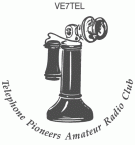 |
| About TPARC |
| Network Map |
| Services |
| Network How-to |
| Node Hardware |
| Membership |
| News |
Some documents linked from this page may require Adobe Acrobat PDF reader.
Last Updated August 2, 2021
Telephone Pioneers Amateur Radio Club
BC Digital Emergency Services Network
Welcome to the Telephone Pioneers Amateur Radio Club!
TPARC operates and maintains a VHF/UHF ROSE switched packet amateur radio network in British Columbia that used to extend from the capital city of Victoria, through the Lower Mainland, up into the interior to Kamloops, and over to the North Okanagan at Vernon.
In 2021, due to on-going maintenance, site access, and site decommissioning issues, the decision was made to scale down the packet network. Where possible, we will continue to provide Winlink packet services, however the ROSE (FPAC) switched packet network nodes will be phased out (due to network fragmentation and lack of use).
In the Lower Mainland, TPARC also operates a VHF and UHF linked voice repeater system on 145.170MHz (-600kHz) and 442.875MHz (+5MHz).
Please see the links at the left for more information.
TPARC is a registered Canadian charity. We accept all monetary donations, as well as in-kind donations of suitable hardware. Tax receipts will be issued, where applicable. Contact the TPARC President (see About Us for contact information) if you wish to make a donation.
Packet Network Changes
2021/08/01
Due to situations beyond our control, after running a wide-area packet network since 1995, we have reached a point where we are no longer able to provide packet radio services at some of our sites.
Some of the challenges stem from site access/maintenance issues and in other cases, sites are being decommissioned/removed by TELUS and others, as they no longer fit in their network plans any longer.
As a result, we are discontinuing packet services at the following sites:
- Smith Hill
- Mt. Sicker
- Dog Mountain
- Silverstar
We will continue to provide Winlink services, where possible, through the remaining sites. The ROSE/FPAC routing will be broken, due to lack of connectivity between sites, however, that part of the system has not seen a lot of use in recent years.
We are also continuing to operate and focus our efforts on supporting the voice repeater system in the Lower Mainland.
Voice Repeater Changes
2016/08/26
In April of this year, we started re-configuration of our voice repeaters at The Boot.
A number of changes have taken place, and here is where we are at today.
The RLC-Club Deluxe controller has been replaced, we are now running an Allstar/Asterisk based controller for the repeaters.
The repeater status can be viewed at http://www.tparc.org/allmon/about.php.
The Yaesu DR-1X is in service in analog-only for UHF, linked to VHF.
A VOTER board and GPS have been interfaced to the ICOM repeater on VHF to support multi-receiver (voting) operation.
A surplus paging amplifier has been installed on VHF to increase the output power to near 100W.
A remote receiver has been installed at our VE7HNY site and added to the voting mix for VHF.
Another voting receiver (portable) is presently operating from VE7FET's QTH.
A third voting receiver is planned for installation on Bowen Island at Cowan Point.
This should drastically improve the receive coverage for VE7TEL VHF, as well as improve where it is heard too.
You can view the receiver status (RSSI) in real-time by following the links on the Allmon page (above).
These changes now let us better support our users by allowing for remote access to the repeaters using a PC client, Android device, or iPhone. It also opens up the opportunity to link other repeaters together using BCWARN/internet connections, similar to how IRLP/EchoLink operates (except we have better control over the linking).
VE7HNY Changes
2016/06/25
Both the VHF and UHF Digipeaters at VE7HNY have been upgraded.
The UHF repeater is back, after a long hiatus.
Both repeaters now incorporate full duplex bit regeneration.
This may require you to increase your TXDELAY.
The repeaters are configured to transparently repeat whatever 1200 baud data they hear, but the signaly will be demodded/remodded and transmitted at a fixed deviation (regardless of the input signal's deviation).
This is akin to "the way it used to be" for you old timers that were around back when the network was young.In addition, you can call VE7HNY-8 (FPAC) or VE7HNY-10 (WinLink/RMS), and the attached node will respond to your call. The call is blocking, so the node will wait until the repeater is quiet to transmit, so it won't walk over anyone repeating through it.
Note that even though we have DCD detect on the receivers, they are running on discriminator audio. This means that randomly there are enough 1's and 0's in the right order to false the DCD decoder (it isn't that smart), so you may hear "burps" of random data on the transmitter. It is easier to just run straight DCD than try and "AND" it with CSQ... it is also faster to detect and transmit.
Thank you for visiting!
Space for our equipment is provided courtesy of TELUS. |
Bandwidth and hosting provided by the BC Wireless Amateur Radio Network. |

